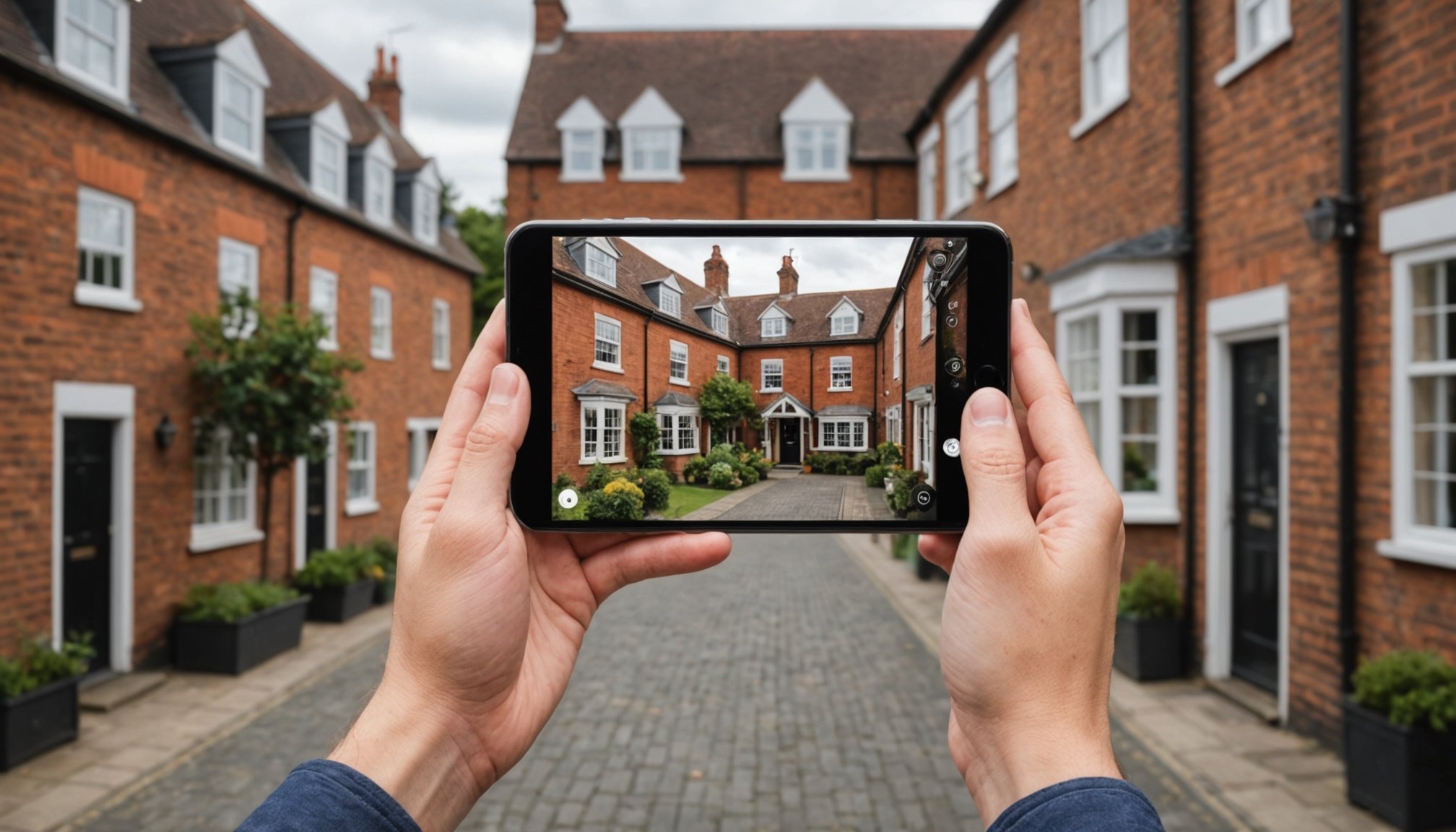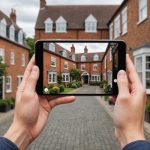Revolutionizing Property Tours: The Impact of Augmented Reality on Real Estate Experiences in the UK
The real estate industry in the UK is undergoing a significant transformation, and at the heart of this change is the integration of augmented reality (AR) and virtual reality (VR) technologies. These innovative tools are redefining how properties are viewed, marketed, and sold, offering a more immersive and engaging experience for potential buyers.
The Rise of Augmented Reality in Real Estate
Augmented reality is no longer just a novelty; it has become a powerful tool in the real estate sector. By overlaying digital content onto the real world, AR enhances the physical spaces, providing an interactive and immersive experience for buyers.
Additional reading : Integrating Smart Fabrics and Wearable Technology: A Comprehensive Approach to Tracking Professional Athletes” Performance
How AR Works in Property Tours
AR technology allows buyers to explore properties in a way that was previously unimaginable. Here are some key ways AR is being used:
- Virtual Tours: AR enables buyers to take virtual tours of properties from the comfort of their own homes. Using smartphones or AR glasses, buyers can navigate through rooms, examine details, and get a real feel for the space without physically being there[4][5].
- Interactive Blueprints: Traditional 2D blueprints are being replaced by 3D interactive models. AR-integrated applications transform flat plans into holographic images that can be rotated and explored in real-time, giving buyers a clearer understanding of the property’s dimensions and layout[1][5].
- Virtual Staging: AR allows buyers to see how furniture and decor would look in a property before making a purchase. This virtual staging helps buyers visualize the potential of the space and makes the decision-making process more informed[5].
Benefits for Buyers and Sellers
The integration of AR in property tours offers numerous benefits for both buyers and sellers:
Additional reading : Revolutionizing User Experience: The Role of AI in Transforming Voice Interface Systems for Enhanced Interaction
- Increased Engagement: AR enhances user engagement significantly. Buyers are more likely to spend time exploring properties virtually, which can lead to higher interest and more scheduled viewings[2][4].
- Cost and Time Efficiency: AR reduces the need for physical visits, saving time and energy for both buyers and estate agents. This efficiency also cuts down on costs associated with multiple viewings[1][4].
- Better Decision Making: With AR, buyers can make more informed decisions. They can see the property in detail, understand its layout, and visualize how it fits into their lifestyle, all from a distance[1][5].
The Role of Virtual Reality in Real Estate
While AR enhances the real world, virtual reality (VR) creates a completely immersive experience, allowing buyers to step into a virtual world.
Virtual Open Houses
VR technology makes virtual open houses possible, allowing potential buyers to explore properties remotely. Here’s how it works:
- Immersive Experience: Buyers can move around rooms, look at details, and get a feel for the space as if they were physically there. This immersive experience is particularly useful for buyers who are unable to visit the property in person[1][4].
- Real-Time Exploration: VR allows buyers to explore properties in real-time, interacting with the virtual environment to get a better understanding of the space. This can include checking out amenities, room dimensions, and other features[1][2].
Enhancing Marketing and Sales
VR is not just about viewing properties; it also revolutionizes the marketing and sales process:
- Visual Storytelling: VR and AR enable real estate professionals to tell a more compelling story about the property. High-quality visuals and immersive experiences evoke emotions and help buyers imagine themselves living in the space[2].
- Faster Sales: Properties listed with VR and AR content tend to sell faster. The ability to showcase a property’s features accurately and engagingly attracts more serious buyers and reduces the time a property spends on the market[2][4].
The Future of Real Estate: Integrating Advanced Technologies
As technology continues to advance, the real estate sector is poised for even more significant changes.
Property Digital Rights and Monetization
The concept of Property Digital Rights (PDRs) is emerging, allowing property owners to control and monetize digital content overlaying their buildings. Here’s how it works:
- Protect and Control: Property owners can decide what AR content is displayed in or around their property, ensuring it aligns with their brand and vision[5].
- Monetize: Owners can generate income by partnering with brands or companies that want to showcase their content in these virtual layers. This could include interactive advertisements or virtual tours[5].
Smart Buildings and IoT Integration
The integration of Internet of Things (IoT) and smart building technologies is also transforming property management:
- Energy Efficiency: Smart buildings use interconnected devices to curb energy use and manage maintenance tasks effectively, promoting sustainability and reducing costs[4].
- Enhanced Property Standards: IoT systems elevate property standards by providing real-time data on building operations, helping in better decision making and property management[4].
Practical Applications and Market Impact
The impact of AR and VR on the real estate market is multifaceted and far-reaching.
Streamlining Transactions
- Smart Contracts: Blockchain technology, often used in conjunction with AR and VR, ensures smoother and more secure transactions. This reduces fraud and makes the property dealing process faster and more reliable[4].
- Data Analytics: Big data analytics provides crucial market insights, helping developers and investors make informed decisions. This analytical approach is vital for the longevity of real estate projects[4].
Job Creation and Market Disruption
The introduction of PropTech, including AR and VR, has sparked job creation and market disruption:
- New Job Opportunities: Innovative solutions by startups are redefining how real estate operates, creating numerous tech-related job opportunities. This not only elevates the industry’s employment rates but also introduces fresh perspectives and talent into the sphere[4].
- Market Growth: The UK’s PropTech sector is expected to grow at a 13% CAGR from 2024 to 2029, reflecting strong investor confidence in the market’s scalability and long-term profits[4].
Table: Comparing Traditional and AR/VR Property Tours
| Feature | Traditional Property Tours | AR/VR Property Tours |
|---|---|---|
| Accessibility | Buyers must physically visit the property. | Buyers can explore properties remotely using AR/VR technology. |
| Engagement | Limited to static photos and descriptions. | Interactive and immersive experience with 3D models and virtual tours. |
| Cost Efficiency | Multiple physical visits can be costly and time-consuming. | Reduces the need for physical visits, saving time and energy. |
| Decision Making | Buyers rely on 2D blueprints and static photos. | Buyers can make more informed decisions with detailed, interactive 3D models. |
| Marketing | Traditional marketing methods like print ads and static photos. | Enhanced marketing through visual storytelling and immersive experiences. |
| Sales Speed | Properties may spend longer on the market. | Properties tend to sell faster due to better engagement and more accurate representations. |
Quotes from Industry Experts
- “Augmented and virtual reality are revolutionizing how properties are viewed. VR enables users to remotely visit homes and offices, offering a comprehensive and interactive exploration without needing to be there physically,” – The Luxury Playbook[4].
- “Visual storytelling in real estate is about creating an emotional connection with potential buyers. High-quality photographs evoke emotions and feelings, helping buyers imagine themselves living in the space,” – Robin Waite[2].
- “Integrating AR into physical spaces can boost a property’s appeal, increase its value, and open new revenue streams. This is a new asset class, offering fresh opportunities for those brave enough to explore this frontier,” – Lianne McOuat[5].
The integration of augmented reality and virtual reality in the UK real estate market is a game-changer. These technologies are not just enhancing property tours but are also transforming the entire real estate industry. From virtual open houses to interactive blueprints, and from smart buildings to data analytics, the future of real estate is indeed augmented and virtual.
As we look towards the future, it is clear that these technologies will continue to shape how properties are bought, sold, and managed. For estate agents, property owners, and potential buyers, embracing these innovations is not just an option but a necessity for staying ahead in a rapidly evolving market.
In the words of Lianne McOuat, “Developing new strategies to maneuver in our fast-paced digital world, where technology shapes how we interact with our environment, energizes me.” The real estate sector is on the cusp of a digital revolution, and AR and VR are at the forefront, making the future of property tours more engaging, efficient, and immersive than ever before.







